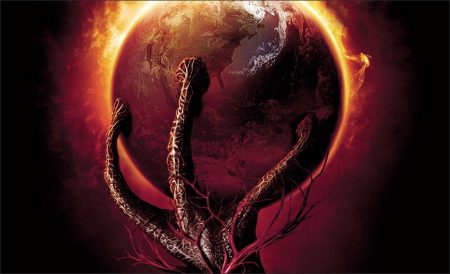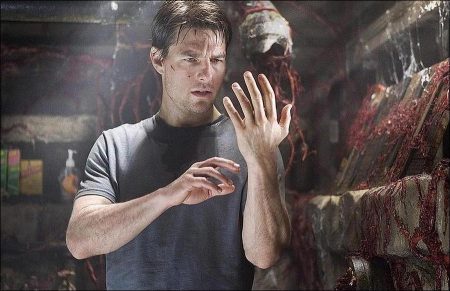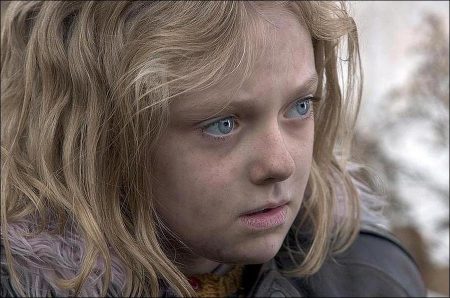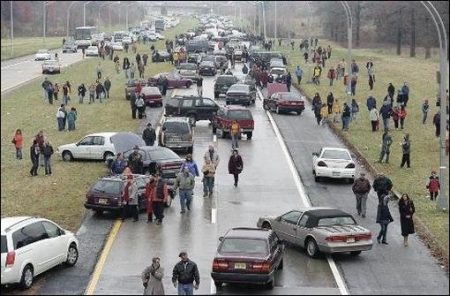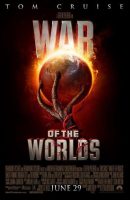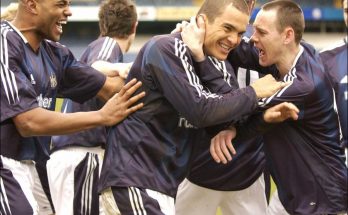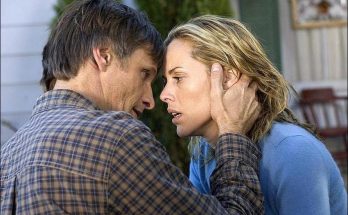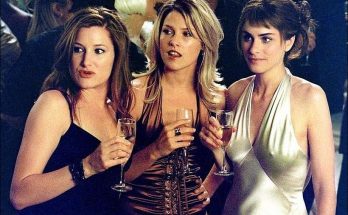About the Film
First published in 1898, The War of the Worlds, H. G. Wells’s seminal story of alien invasion, is a literary classic. The frightening specter of our planet being ripped from us – with ordinary human lives held in the balance like ants on a twig – has retained its power for over a century. For Spielberg, the story is especially resonant today. “I thought now would be a good time to send `War of the Worlds’ crashing down around everybody’s ears,” says the Academy Award-winning director. Known for films about more hospitable intergalactic guests, Spielberg was eager to revisit the idea of alien visitation, but he warns anyone looking for long-fingered friendly space travelers: “This is not one of my sweet, cuddly, benign alien stories.”
“This is E.T. gone bad,” says Tom Cruise. “You do not want to run into these aliens.” Cruise plays Ray Ferrier, who is faced with the test of fatherhood when the aliens attack. “The question is: are they going to make it?” says Cruise. “Will they survive? And to what extent would you go to protect your children?”
“War of the Worlds” marks Spielberg and Cruise’s second collaboration, after “Minority Report.” “Having known each other for many, many years, this has brought a whole new evolution to our relationship as director-actor,” comments Spielberg. “He’s such an intelligent, creative partner, and brings such great ideas to the set that we just spark each other. I love working with Tom Cruise.”
Producer and longtime collaborator Kathleen Kennedy notes that with “War of the Worlds” Spielberg had the opportunity to explore the antithesis of the characters brought to life in “E.T.” and “Close Encounters of the Third Kind.” “When we first started developing `E.T.,’ it was a much edgier, darker story and it actually evolved into something that was more benign. I think that the edgier, darker story has always been somewhere inside him. Now, he’s telling that story.”
“This is the flip side of what we saw twenty years ago,” adds production designer Rick Carter. “Back then, we were introduced to some alien forms that were very benign and our great fears about them turned out to be ill-founded. The child in us understood that. For the man that Steven is now and the times that he’s living in, those aliens take on a different form.”
Far away from the halls of the Pentagon or the Oval Office, “War of the Worlds” takes place in an ordinary world. “This is a very simple story,” says Spielberg, “it’s a story about survival, about a father trying to keep his children safe. It’s about the basic elements of human nature set against an extraordinarily unnatural event.”
Cruise notes that from the beginning, Spielberg described the film to him in subjective, rather than objective, terms. “You understand that the whole world is under attack but it’s all from the point of view of Ray Ferrier,” Cruise says. “He has a great perception of human behavior. He finds those unique moments, those little things. Steven does that with his movies and it brings you right into those characters and their stories. You’re connected with them, so things that are frightening are really frightening. It’s happening to us, the audience.”
“I wanted Ray to become like a lot of people,” says Spielberg, “because he has to represent all of us. He and his family are representing our own fears, our own facilities to survive, our own resourcefulness.”
Like H. G. Wells, Spielberg was intent on telling a contemporary story, on bringing the aliens into the world we know. “The story may be something born out of a fantasy notion but in fact is dealt with in a hyper-realistic way,” says Kennedy. “Steven is always exploring the extraordinary set against the ordinary and he continues to pursue that theme in `War of the Worlds.’”
It’s a theme that finds its way back to H. G. Wells’s novel. Co-screenwriter David Koepp, along with Josh Friedman, was charged with telling the epic story on a personal scale. “That’s really the brilliance of the screenplay,” says Kennedy. “It adheres to something that H.G. Wells presented – the idea of a personal point of view. Ray and his family are being affected personally by what’s happening.”
Koepp, who helped Spielberg bring dinosaurs crashing into our contemporary world in “Jurassic Park” and “The Lost World,” says keeping the story simple was a necessity. “My feeling was that an invasion of the Earth is such an impossibly large subject that we could never record what that might be like,” he says.
As a result, the screenwriters focused on the attack’s effect on one family. “We needed to go exactly the other way. The more you focus on these three main characters and their dilemmas – their confinement, their lack of information – the more terrible and personal it becomes,” says Koepp.
“Steven and I talked about how this was the biggest `little film’ we’ve made,” Cruise adds. “It’s an epic – it’s the biggest single film I’ve ever been a part of. But it’s also a very intimate story about a family. Steven, David and I talked about it as a film that we dedicate to our children and how much we love them. I think it’s a film that represents what parents feel about how far you’re going to go for your child.”
Wells’s story has had such a lasting impact on our culture that it’s difficult to imagine that at the time it was published the concept of visitors from outer space was radical and new. The War of the Worlds laid the foundation for a genre – books, films, television and at least one musical about alien invasion.
“The novel seems to come back each time there is a fear of an invasion, us in a sense,” comments H.G. Wells’s grandson, zoologist and author Dr. Martin Wells, who visited the set with his family. “The British were nervous of the Kaiser about the time the novel was published. There is a significance to the world that it’s being introduced to, whether it has been in broadcast or in film, or in literature.”
“When I read the Wells novel, I was struck by his tremendous imagination in creating this believable scenario that puts the reader in that time and place,” says Cruise.
Director Spielberg wanted to adhere to the power of Wells’s story while avoiding some of the clichés it has spawned. “We made a list of things we felt we shouldn’t have in the movie,” says Koepp. “No destruction of famous landmarks, no shots of Manhattan getting the crap kicked out of it, no shots of generals standing around a large map pushing ships with sticks into place, no TV news crews photographing destruction.
Spielberg and Cruise were looking for a film they could make together after their successful collaboration on “Minority Report.” “It’s a dream come true for me to be able to work with Steven Spielberg,” says the actor. “I grew up watching his movies, studying them. I often tease him that I know his movies better than he does! It’s a real lesson in storytelling – every time I look at his films, I learn something.”
The opportunity revealed itself just prior to the release of “Minority Report” while Cruise was visiting the director on the set of his film “Catch Me If You Can.” “He mentioned three movies; `War of the Worlds’ was the third,” Cruise recalls. “We looked at each other and the lights went on. As soon as I heard it, I said `Oh my God! “War of the Worlds” – absolutely.’ That was it.”
An international superstar and three-time Academy Award nominee, Tom Cruise brings extraordinary energy and complexity to the role of Ray Ferrier. “Tom just lights the film on fire,” comments Spielberg, “he has a tremendous life force and an extraordinary presence. He has a kind of light that lights up scenes, and lights up the character.”
Cruise’s enthusiasm and energy on set were infectious, as actor Tim Robbins notes, “there is no slouching,” says Robbins. “He’s a professional and a generous actor. If he’s off-camera for you, he’s completely in character, completely giving one hundred percent.”
Ray Ferrier was a far cry from the noble or diabolical characters Cruise had brought to life in recent films. As Spielberg recalls, “I said to Tom when we first started working on this project, `I really want to make a movie where your character isn’t heroic – he’s running away.’ Ray’s larger agenda is, `How do I keep my family together? How do I keep my kids safe?’ Tom was really game for that. He was excited that the only war he was going to fight was the war to keep his family safe.”
The personal story at the heart of this epic odyssey is one with an unlikely hero. “At the beginning of the movie, Ray is truly inept as a father,” Koepp explains. “He’s not really interested in being a father, primarily because he thinks he’s not good at it. And he isn’t. He has been a failure. The kids don’t like him and they don’t like coming to his house.”
“I’m a very different father than Ray is,” Cruise says. “He doesn’t understand his kids; he only understands himself. When things go wrong, he looks to them. He’s more of a kid than they are.”
“Ray’s really been unable to commit to being a father,” says Kathleen Kennedy. “He’s been reluctant to grow up. That’s the journey he’s about to take – he’s got to understand that participating in the lives of these children is the most important thing he could do.”
At the story’s center, surrounded by death and destruction, is the emotional journey taken by Ray and his children. “It’s the very thing that separates this movie from a lot of other movies in this genre,” says Kennedy, “because it is very character-driven. It’s very specific to the dynamic of this family and the dynamic of survival.”
A painful distance exists between father and children when the story begins. Rachel (Dakota Fanning) and Robbie (Justin Chatwin) shuffle their feet up to their father’s house with something less than enthusiasm for their rare weekend visit. But the challenges Ray faces with a surly teenager and a reticent young daughter quickly pale in the face of what’s to come.
It’s only a short time after his ex-wife and her new husband drive off that Ray comes face-to-face with a father’s ultimate test, which, as Spielberg explains, is “to protect your loved ones and, if necessary, to flee for their lives.”
When the Tripod attack begins, there is little to do but try to stay alive. “We can be as intellectual as we want about stopping an enemy,” comments senior visual effects supervisor Dennis Muren. “We can be as persuasive as we can. And we can put all our armament against it, but you can’t stop this. It’s your worst nightmare you’re facing. You can feel that happening to anyone in America.”
With the world literally crashing down around them, the familial tensions are heightened exponentially. Within minutes the world changes and Ray Ferrier must become the father he has, up to now, failed to be or he and his children will die. “This is a film that represents a parent’s worst-case scenario,” says Cruise. “Ray’s got to become a different kind of parent than he’s ever been if they are going to survive.”
Ray’s daughter Rachel is played by 11-year-old acting phenomenon Dakota Fanning. The young actress starred in the award-winning television miniseries “Steven Spielberg’s Taken” and starred in the DreamWorks film “The Cat in the Hat.”
“Dakota Fanning was on my mind the second I decided to make `War of the Worlds,’” says Spielberg. “I know no one her age that’s better than she is and more intuitive about human nature. She has a very wise old soul – it’s like she’s been around about seven or eight times.” This inherent wisdom worked well for the actress playing the daughter of an up-to-now unsuccessful father. As the director explains, “In certain instances, her character is a little wiser than her own father and that made for some interesting interplay.”
Fanning, who has now starred opposite the likes of Robert De Niro and Denzel Washington, is a formidable actress. “The first scene that I saw her shoot,” recalls Tim Robbins, “I thought, `Man, this girl’s 35 years old.’ She was so focused, and so there emotionally, immediately. She has incredible maturity for a kid.”
For Fanning, it was a dream job working with Spielberg and Cruise. “To work with Steven and Tom in the same film, I’ve learned so much from them,” adds Dakota Fanning. “I’m so grateful for the opportunity to work with Steven, and Tom made everything fun. He’s so nice and he’s made everything really special.”
For the role of Rachel’s brother, Robbie, Spielberg cast newcomer Justin Chatwin. “I looked a long time for somebody to play Tom’s son,” says the director.
“We’d seen Justin in `Chumscrubber,’” recalls producer Kathleen Kennedy. “He made a phenomenal debut in that movie and he’s completely holding his own in the contentious relationship Robbie has with his father, with very believable 17-year-old behavior.”
Robbie is at that impossible age when young people yearn for both acceptance and independence, and it’s made all the worse by the gulf that exists between him and his father. “Justin was cast both against type and on type, because I felt that he played a good rebel,” says Spielberg. “He speaks for a whole generation of kids who don’t agree with anything their parents say or wear.” Robbie wears his defiance of his father boldly, his red and white Red Sox cap in stark contrast to his father’s Yankee blue.
While there is plenty of friction between on-screen father and son, off-screen, Cruise provided a solid anchor for the young actor. “Tom was always there for me,” says Justin Chatwin. “It’s great working with such a big star who is just there for you as an actor.”
The bond between brother and sister compensates for whatever lacks in their relationship with their father, their broken home and their mother’s new life. “It’s a contemporary story about a family that’s broken apart,” explains Justin Chatwin. “The father and son cannot connect. The father and daughter cannot connect. And the brother and sister are living in a world where they only have each other.”
During production, the bond between siblings translated into a close friendship between the two young actors. “Justin is a like a brother to me now,” says Dakota Fanning, “because we were together so long – in New York, Virginia, and California. So he’s like my real brother. We have fun.”
For Chatwin, the young actress was an inspiration. “Dakota Fanning is a beautiful kid,” he says. “She’s got a great head on her shoulders. She is phenomenal. I don’t know where she learned to act, but I am learning from her every day.”
Australian Miranda Otto was on a brief visit to Los Angeles when her agent phoned to tell her Steven Spielberg wanted to meet her. But Otto feared that the chance to work with Spielberg may have come at the wrong moment. “I had to say to him, `I don’t know if I can do this because I’m pregnant,’” recalls Otto. But the pregnancy worked for Spielberg, who saw it as a part of the complexity in the relationship between ex-wife and ex-husband.
As Kennedy explains, “It’s not as though these two people don’t like one another; they do. They still care very much for each other and they both care very much for their children, but the relationship hadn’t really worked.” The actress’ pregnancy, which was accentuated for the film, helped to finalize her character’s transition into a new life.
“There’s this sweet gap between Ray and Mary Ann,” says Spielberg, who envisioned the couple as two people who married young and were never able to transcend their different social backgrounds. “He’s this blue-collar worker who unloads those big cargo containers and is a big kid at heart. He married a Connecticut aristocrat, someone who had horses growing up, and they fell in love and had a couple of kids. But he’s a sexy guy – he’s Tom Cruise after all – and she’d found something in Ray she loved despite still having this other lifestyle. There was such a great chasm between their upbringings that they never really could see eye-to-eye on many things. And I thought that contrast was great.”
The stranger who waves the father and his daughter away from the alien attacks is a broken man named Ogilvy, played by Academy Award-winning actor Tim Robbins. “Ogilvy is a guy who has lost his entire family, as so many people have,” says Spielberg. “He has been hiding out in the basement of this farmhouse. He has a plan, but that plan is deranged. You forgive him some of his derangement because he has suffered such a great loss and he’s not thinking clearly, but he becomes as much a danger to Ray’s and Rachel’s survival as the invaders.”
War of the Worlds (2005)
Directed by: Steven Spielberg
Starring: Tom Cruise, Miranda Otto, Dakota Fanning, Tim Robbins, Justin Chatwin, Rick Gonzalez, Yul Vazquez, Lenny Venito, Lisa Ann Walter, Ann Robinson, Camillia Monet
Screenplay by: David Koepp
Production Design by: Rick Carter
Cinematography by: Janusz Kaminski
Film Editing by: Michael Kahn
Costume Design by: Joanna Johnston
Set Decoration by: Anne Kuljian
Art Direction by: Tony Fanning, Doug J. Meerdink, Andrew Menzies, Norman Newberry
Music by: John Williams
MPAA Rating: PG-13 for frightening sequences sci-fi violence, disturbing images.
Distributed by: Paramoount Pictures, DreamWorks Pictures
Release Date: June 29, 2005
Visits: 124
